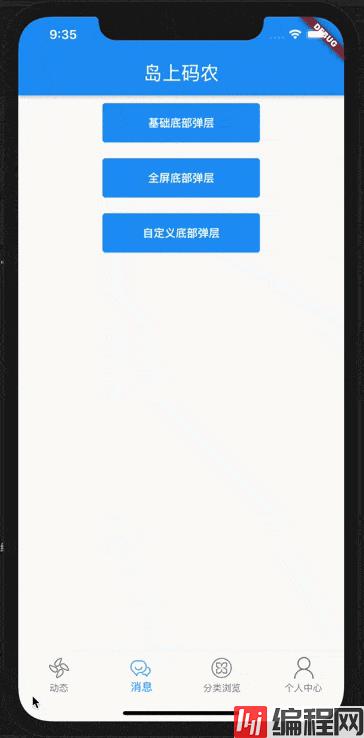目录实现效果 代码结构 基本使用 自定义底部弹窗 总结 实现效果 最终实现效果如图片所示,分布演示了基础的,全屏的和自定义的底部弹窗形式。 代码结构 在消息页面 message
最终实现效果如图片所示,分布演示了基础的,全屏的和自定义的底部弹窗形式。

在消息页面 message.dart 中,使用 Column 组件构建了三个按钮,点击每个按钮调用不同的底部弹窗显示。这部分代码不展示,核心注意的方式是按钮的 onPressed 响应方法,需要使用 async 修饰,这是因为 ModalBottomSheet 的返回结果是一个 Future 对象,需要通过 await 来获取返回结果。
onPressed: () async {
int selectedIndex = await _showCustomModalBottomSheet(context, _options);
print("自定义底部弹层:选中了第$selectedIndex个选项");
},
//...
基本使用对于全屏和默认只差一个参数,演示代码中,我们使用了一组模拟的数据构建选项数据,然后再传给显示底部弹窗的方法,实际这组数据大部分是从后台获取的。当 isScrollControlled 是 true 时,则是全屏弹窗,默认是 false。
Future<int> _showBasicModalBottomSheet(context, List<String> options) async {
return showModalBottomSheet<int>(
isScrollControlled: false,
context: context,
builder: (BuildContext context) {
return ListView.builder(
itemBuilder: (BuildContext context, int index) {
return ListTile(
title: Text(options[index]),
onTap: () {
Navigator.of(context).pop(index);
});
},
itemCount: options.length,
);
},
);
}
需要注意的有四点:
在自定义底部弹窗中,我们做了如下自定义项:
自定义弹窗的代码如下所示:
Future<int> _showCustomModalBottomSheet(context, List<String> options) async {
return showModalBottomSheet<int>(
backgroundColor: Colors.transparent,
isScrollControlled: true,
context: context,
builder: (BuildContext context) {
return Container(
clipBehavior: Clip.antiAlias,
decoration: BoxDecoration(
color: Colors.white,
borderRadius: BorderRadius.only(
topLeft: const Radius.circular(20.0),
topRight: const Radius.circular(20.0),
),
),
height: MediaQuery.of(context).size.height / 2.0,
child: Column(children: [
SizedBox(
height: 50,
child: Stack(
textDirection: TextDirection.rtl,
children: [
Center(
child: Text(
'底部弹窗',
style: TextStyle(
fontWeight: FontWeight.bold, fontSize: 16.0),
),
),
IconButton(
icon: Icon(Icons.close),
onPressed: () {
Navigator.of(context).pop();
}),
],
),
),
Divider(height: 1.0),
Expanded(
child: ListView.builder(
itemBuilder: (BuildContext context, int index) {
return ListTile(
title: Text(options[index]),
onTap: () {
Navigator.of(context).pop(index);
});
},
itemCount: options.length,
),
),
]),
);
},
);
}
这里有几个额外需要注意的点:
本篇介绍了三种 ModalBottomSheet 的方式, 可以看到 ModalBottomSheet 非常灵活。实际开发过程中,还可以根据需要,利用 ModalBottomSheet的 builder 方法返回不同的组件进而定制自己的底部弹层组件,能够满足绝大多数场景。同时,借 ModalBottomSheet 的启发,我们自己也可以使用 Navigator方法来实现其他形式的弹层,例如从底部弹出登录页,登录后再返回原页面。
以上就是Flutter 底部弹窗ModelBottomSheet的使用示例的详细内容,更多关于Flutter 底部弹窗ModelBottomSheet的资料请关注编程网其它相关文章!
--结束END--
本文标题: Flutter 底部弹窗ModelBottomSheet的使用示例
本文链接: https://lsjlt.com/news/127730.html(转载时请注明来源链接)
有问题或投稿请发送至: 邮箱/279061341@qq.com QQ/279061341
2024-01-21
2023-10-28
2023-10-28
2023-10-27
2023-10-27
2023-10-27
2023-10-27
回答
回答
回答
回答
回答
回答
回答
回答
回答
回答
0